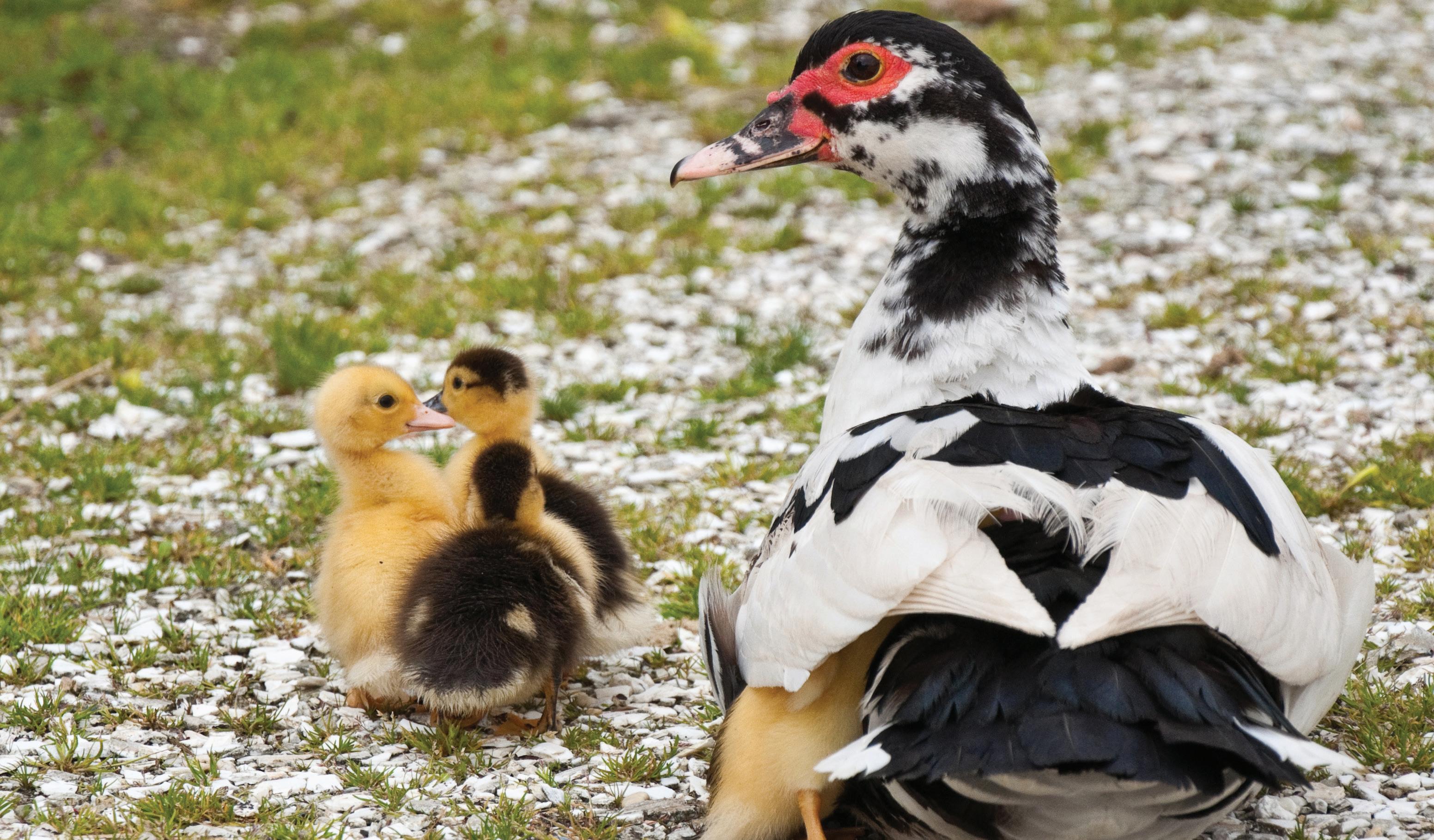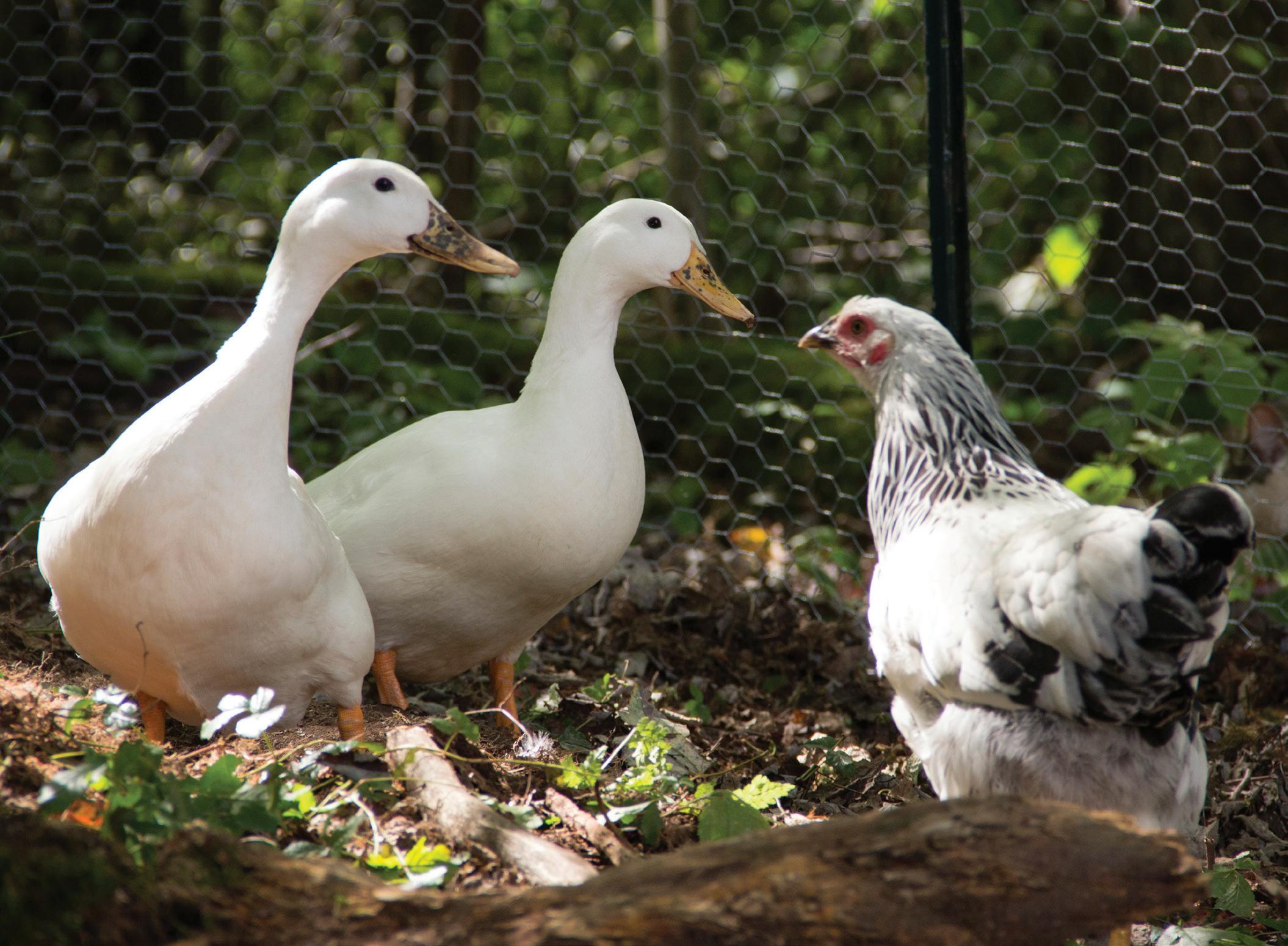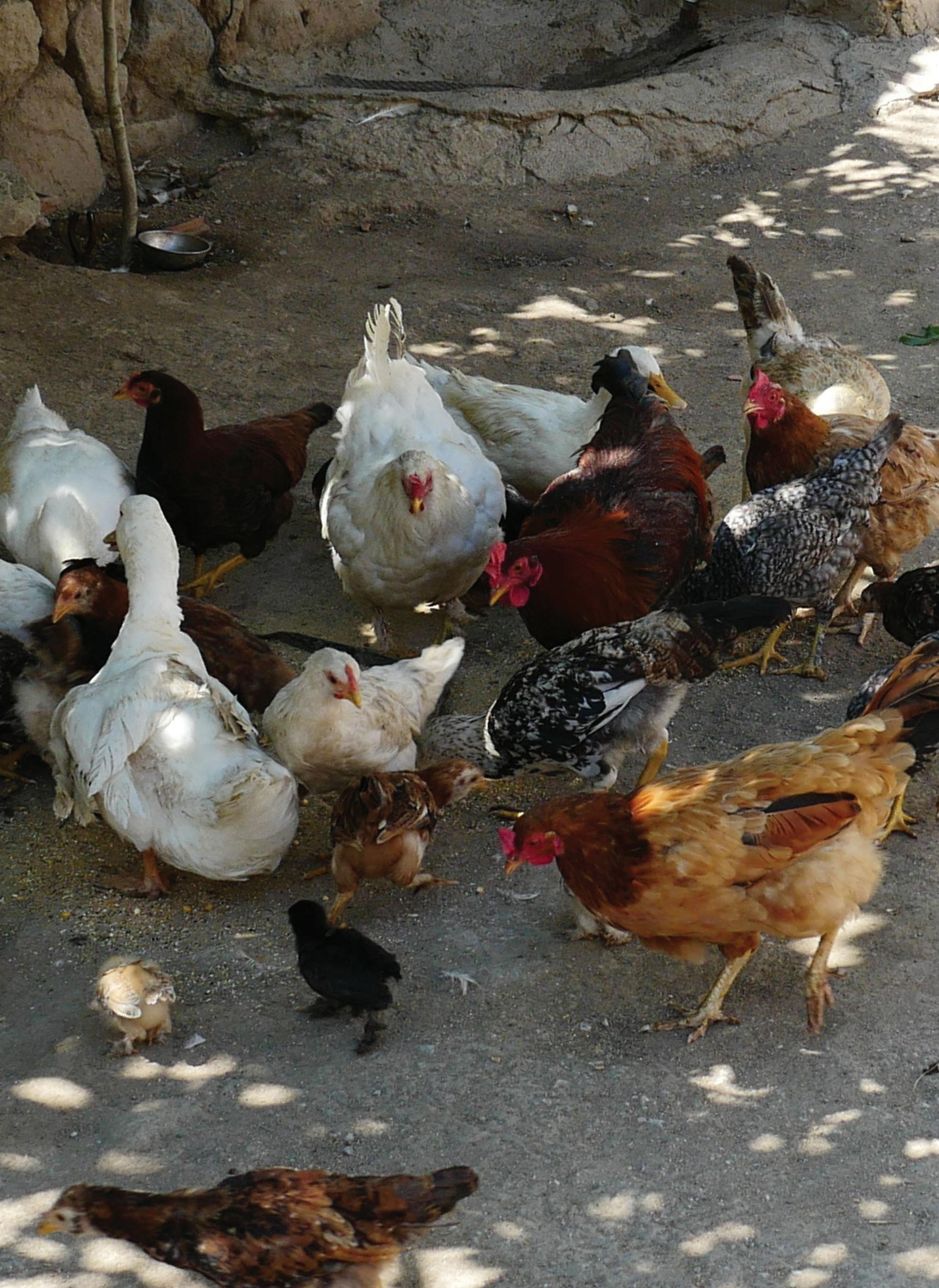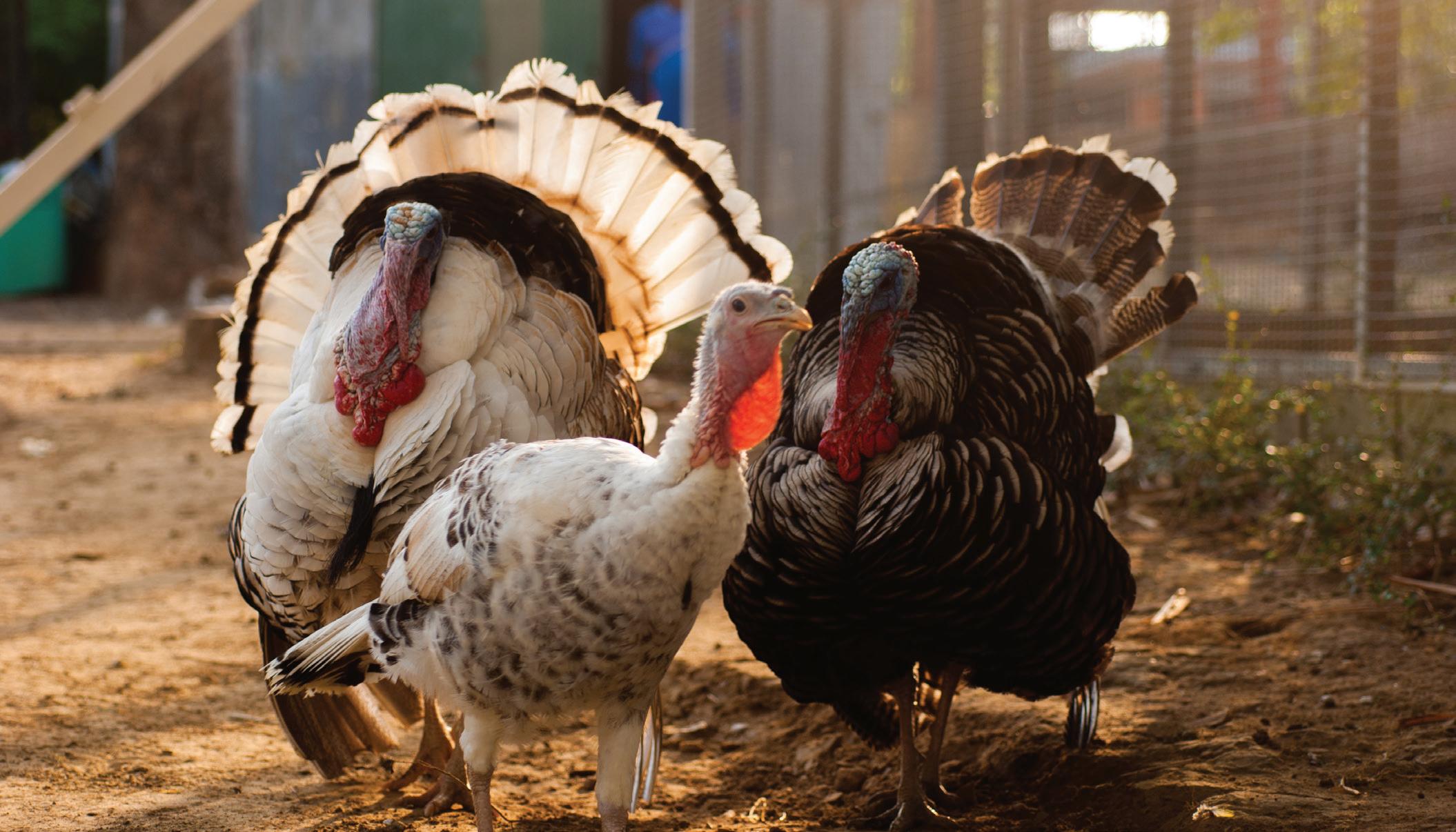WHAT DO YOU FEED BABY DUCKS FOR PROPER GROWTH?
HOW MUCH PROTEIN IS ENOUGH?
STORY BY JANET GARMAN
If you’ve decided ducklings will find their way to your home from the feed store or the hatchery, then youʼre probably wondering what to feed baby ducks. This is an important consideration in your journey to learn how to raise ducklings.
Believe me, a lot of chicks and ducks have found their way to our farm. And even though Iʼve been raising ducklings for a number of years, I recently realized that not everything Iʼd learned about feeding ducklings was working. Here are some points on which Iʼve changed my mind concerning what to feed baby ducks for proper growth.

10 BACKYARD POULTRY WATERFOWL
1. I'm no longer feeding baby ducks a poultry grower ration containing 20% protein past the second week of life.
This was the way everyone I knew was feeding baby ducks. However, feeding them duck food thatʼs a meat bird ration or a duck raiser ration can actually be too high a protein content for the ducklings long term. I was told for many years to use this type of feed until the ducklings were nearly grown, but Iʼve seen negative consequences from this practice. If youʼre raising ducklings for meat, feeding a high protein ration may be the correct formula, since the sooner you reach market weight, the better. But when youʼre keeping ducks as pets or as egg layers or breeders, the high protein during weeks 2 to 14 of growth can lead to conditions such as "angel wing" or "twisted wing." This happened to one of the ducklings we raised from hatch here on the farm. As I had with the previous ducklings, I fed a commercial flock raising ration until the ducks reached 14 to 16 weeks of age. However, when one duckling developed angel wing, I looked
into the causes and prevention. The extra protein during the period of development from 2 weeks to 10 weeks can lead to very fast bone growth resulting in a twisting or bending of the bones in the wing. It usually only affects one of the wings. Keeping ducks as pets in a fenced enclosure, you may not have any noticeable problems from the abnormal growth but ducks allowed to free range or ducks in the wild wonʼt move as quickly, wonʼt be able to fly at all, and will be easier for predators to catch and kill.
The recommendation, according to experts like Dave Holderread of Storey’s Guide to Raising Ducks, is to feed the 18% to 20% protein ration only for the first two weeks of a duckling’s life. Next, switch to a 16% protein ration for the rest of the duck’s life. In addition, allowing the ducks some free ranging time, if it can be supervised to avoid predator attacks, will benefit the duck’s diet greatly. Alternatively, you can forage for them and take greens, weeds and grasses, cut them up and put them in the duck pen.

11 backyardpoultry.iamcountryside.com
If you're raising ducklings for meat, feeding a high protein ration may be the correct formula, since the sooner you reach market weight, the better.
2. I no longer feed ducks bread products, and I don’t feed stale bread to wild ducks either. Feeding high-protein, high-carbohydrate bread products to ducks can also lead to fast growth and twisted bones as the ducklings grow. Flocks of ducks that arenʼt fed treats show no sign of angel wing or abnormally quick bone growth. If the duck canʼt act and move quickly to try to escape a predator, it is, in reality, a sitting duck.
3. The treats I do bring my ducks consist of what they'd be looking for in the wild. Although I do allow my flock to free range when I can keep an eye on them, I still bring them some goodies. After all, it’s part of the fun of having them around. But instead of giving them any old foods from the household, I limit their treats to foods that are healthy for them. Here are some healthy items that our ducks love.
• Chopped kale
• Bite-size pieces of romaine lettuce or Swiss chard
• Watermelon
• Small amount of cooked pumpkin
• Peas, carrots, cooked green beans
• Chickweed and smartweed; packed with minerals and nutrition, grow in abundance on our farm and are enjoyed by the flock.
• Mealworms. My ducks wouldnʼt be happy if I didnʼt bring the mealworms occasionally.
These are given as a treat so, of course, they arenʼt eating them every day or in great quantity. However, mealworms are high in protein, so theyʼre a good choice during molting and are a tasty way to entice the ducks back into the duck run at night.
WHAT TO FEED BABY DUCKS FOR GROWTH

Iʼve switched to using a flock raiser or higher protein non-medicated chick starter ration for only the first two weeks of growth with ducklings. From weeks 3 to 14, I feed a 16% protein grain ration. After the ducklings are fully grown, feed either the flock raiser ration if youʼre able to supplement enough with free ranging time or bringing in weeds, and greens and grasses. Otherwise, I use a 16% protein ration unless conditions call for a higher protein ration. These conditions might include the absence of egg laying. It’s not at all a one size fits all feeding plan when caring for ducks in captivity. You must look at the total environmental picture and then feed accordingly for a healthy, happy duck.
Let me also state that Iʼm not an expert at raising ducks and you should always do what you feel is right for your flock. Learn all you can about the nutritional needs of any animal and feed accordingly, using the best ingredients you can source.
12 BACKYARD POULTRY WATERFOWL
Muscovy duck and ducklings.
PROTECTING DUCKS FROM PREDATORS
FIXING GAPS AS YOU FIND THEM AND ADDING NEW PROTECTIONS.
With shorter days and weather changes of each season, you’ll likely see an uptick of predators testing the security of your duck pen.

It’s a common complaint from flock owners, but there are a lot of ideas you can implement to keep your webfooted friends from becoming a meal for free-loading coyotes, raccoons, and other carnivores.
When creating a “duck safety plan,” it’s important to remember that ducks aren’t chickens. While hens and roosters can perch, run very fast, or fly into tree branches, most domestic duck breeds (except Muscovies) can’t do any of that.
They CAN swim out into ponds and other bodies of water, but in most domestic settings, they won’t have that option.
We used to think we had just a couple of predators on our farm until I put out a game camera one night. Boy, were we wrong! So, even if you think your flock is safe, you might be surprised. It’s better to be safe than sorry!
So, what’s a duck keeper to do? Don’t fret!
Here’s a list of eight battle-tested strategies to keep quackers safe that have worked on my farm for years.
KEEP FEED (AND YOUR DUCKS) LOCKED UP AT NIGHT
Consider this your “first line of defense.” Nothing is more attractive to predators than an easy meal, which includes your duck’s feed.
Scavengers such as opossums and raccoons are attracted
34 BACKYARD POULTRY
WATERFOWL
STORY AND PHOTOS BY MAAT VAN UITERT
Gaps like this in your fencing are an open invitation to predators.
to the sweet and sometimes overpowering smell of livestock feed, and a midnight raid on your feeder can easily turn into opportunists that attack your flock!
Using an automatic feeder that stays in the coop or one that locks when not in use like Grandpa’s Feeders is a good idea. You can also craft your own DIY feeder.
Similarly, making sure your ducks are bundled up tight in their coop at dusk is another way to avoid losing your flock. We’ve trained our ducks to go into their coop at sundown by offering treats only at this specific time. The first couple of days, your ducks might be confused, but they’ll get the hang of it very quickly.
ALWAYS USE A PREDATOR-SAFE COOP
Assess whether your coop is 100% predator safe. Because ducks are hardy creatures that get excited and want to play during rain or snowstorms, it’s tempting to give them a run with a simple duck house and forget to lock them up every night.


However, it’s important to provide them with a home that can completely shut out predators. All windows should lock or have a tight-fitting wire that covers the opening.
Similarly, doors should shut completely. Double-check your doors and windows for small cracks that wily weasels or minks can wiggle through. If you see daylight, fix it. Using rubber guards you can find at most hardware stores are a good option.
The door should also lock.
35 backyardpoultry.iamcountryside.com
(Top) A feeder like this can easily be removed at night, and are large enough for flock members of all sizes. (Bottom) Chicken wire may be good for keeping chickens in, but not for keeping predators out.
Our ducks are very clever and discovered they can open unsecured doors by running towards them and pushing on them. While an evening stroll towards their pond might seem like a good idea, it’s also an open invitation for a predator to sneak into their coop at midnight. But their round bills can’t open a lock. Just make sure the lock is high enough that a raccoon can’t reach it.
HEAVY OR STAKED TO THE GROUND
I see lots of beautiful coops out there for ducks, but most look pretty easy to overturn for a large and determined domestic dog, wolf, or bear. (You might think that bears aren’t common predators, but I get at least one email a month from a reader who lost her flock to a grizzly or black bear.)
We use a large coop that’s essentially a huge garden shed. It’s impossible for any animal to overturn it.
But if your coop isn’t very heavy, secure it to the ground with 4-by-4 posts, rebar, or your own favorite method. One tip I love is to use 8-foot landscape timbers. They’re inexpensive and work just as well as 4-by-4 posts.
SINK HARDWARE CLOTH
You probably already know to use hardware cloth on your flock’s coop and run. For some extra protection against digging
predators, including domestic dogs and foxes, embed an extra few feet of hardware cloth or chicken wire into the ground on the outside of your run.
While it might seem an obvious way to keep predators out of your coop, it’s also a handy way to keep your ducks in their protected zone. Ducks are naturally curious, especially if there’s a tempting puddle just asking to be splashed in or a garden waiting to be plucked of slugs. Sometimes, the temptation is too much, and your ducks will refuse to stay put if they can find a way out of their run.
To accomplish this, dig a 12-inch to 24-inch-deep trench around your
ducks can’t wiggle through and explore your yard at their peril.
INSTALL LIGHTS TO SCARE OFF PREDATORS
Using a motion sensor light or a light that turns on and off at random intervals is another option. We’ve used them successfully on our farm to keep coyotes and foxes at bay.
Most predators that aren’t used to human presence, such as wolves and coyotes, might be frightened by a sudden flash of light. If your coop doesn’t have electricity, you can find solar-powered options.
You can also find products that flash strobe lights, such as Predator Guard. In some cases, strobe lights might work better for animals used to human company, such as raccoons and skunks because they find the strobe visually confusing and disorienting.
coop that’s also the same width as your hardware cloth. The depth is up to you and your individual situation. On our farm, we go with a 12-inch depth, but we don’t have very aggressive predators during the day. If you have determined predators, 24 inches might be a better option so the wire can’t be pulled up.
The key is to make sure the sunken hardware cloth is an extension of the run wall itself and not a separate piece. This ensures carnivores can’t dig under your coop wall and your
HOUSE YOUR DUCKS WITH A LARGE ANIMAL
This idea won’t work for every farm, but if you have goats, donkeys, alpacas, or llamas, they can do “double duty” and protect your flock from smaller predators like raccoons, skunks, or opossums. We’ve kept our ducks with our goats for years and I swear we haven’t lost any ducks because the goats keep predators at bay. Think about it: predators don’t want a fight. They’re opportunists. If they think a larger
36 BACKYARD POULTRY WATERFOWL
When creating a “duck safety plan,” it’s important to remember that ducks aren’t chickens.
critter will make it difficult to get a meal, they’ll look elsewhere.
USE A RADIO OR OTHER SOUND MAKER
Some products on the market use ultrasonic waves to deter unwanted visitors. These waves can’t be detected by humans but can be felt by predators, kind of like a dog whistle. These might be a great option if you live in a suburban area and your neighbors might not appreciate a motionsensor light going off at all hours. Many of these products are solarpowered and reasonably priced. It’s best to follow the manufacturer’s instructions for installation.
Turning on a radio with music, podcasts, or talk radio is another low-cost option that can be effective. Most predators prefer to lurk around at night when humans won’t disturb them. But if they think a person is nearby, they’ll find another meal for the night. You might also find that music or talk radio relaxes your flock and reduces stress.

TEST DRIVE A “PRICKER”
While this idea might not be for everyone, it’s still an option on the table. Prickers are plastic strips with small spikes that protrude. They don’t trap predators; instead, they just make the area unappealing
to walk on. Don’t worry: While they repel predators, they won’t harm them, since a coyote or other carnivore will only need to touch them one time before they head the other direction.
MAAT VAN UITERT is the founder of the backyard chicken and duck blog, Pampered Chicken Mama, which reaches approximately 20 million backyard poultry enthusiasts every month. She’s also the founder of the Living The Good Life With Backyard Chickens store, which carries nesting herbs, feed, and treats for chickens and ducks. You can catch up with Maat on Facebook and Instagram.
37 backyardpoultry.iamcountryside.com
Keeping a Blended Flock
Keeping a mixed flock is a thought that’s bound to cross your mind when those spring chicks start arriving at the feed store. Maybe you have chickens and you think you might like to add some ducks.
The short answer is that mixed flocks aren’t too complicated. However, the longer one is that different species do have different considerations to take into account.
TURKEYS
Our first venture into a mixed flock came when we decided to add turkeys to our backyard poultry business. We were already selling eggs and selling our pasture-raised chicken. Turkey seemed a natural complement to that, so I ordered six broad-breasted white turkey poults and a batch of Cornish Cross chicks from my local hatchery. I was surprised when I picked the birds up to see the hatchery had given me nine poults. I’d soon learn why. We lost several poults to blackhead disease. According to the Merck Veterinary Manual, blackhead disease is caused by the protozoan Histomonas meleagridis, which can infect many species of birds. Chickens often are asymptomatic carriers, meaning the protozoan is present in their bodies but doesn’t cause illness in them.
I’ve heard that other varieties of turkeys, such as heritage breeds (for example, Bourbon Reds), can be more resistant to blackhead disease. I haven’t ventured into raising turkeys again to test the theory.
STORY BY TRACI DE LORE
Maybe you have ducks and want to expand into more waterfowl with geese. Or maybe you’re thinking about a big, juicy turkey at Thanksgiving, and you figure it can’t be that hard to raise a few turkeys alongside your chickens.
Aside from them dying on me, turkeys were relatively easy to keep. The survivors thrived on a gamebird feed and were always waiting inside the coop for me to lock them in each night.
DUCKS
My mixed flock now consists of several dozen chickens and three white Pekin ducks. My

93 backyardpoultry.iamcountryside.com
Mixing it up: Birds of a different feather CAN flock together.
daughter, who became infatuated with the fuzzy yellow ducklings every time we saw them at the feed store, begged me to get some until I finally caved in.
Just know in advance if you have ducks, they are going to make a mess in and with any water they find. Mine bathe in the water dishes and splash in puddles: There’s a reason my outdoor goldfish pond now has a fence around it.
Ducks don’t need to swim, but they do need access to water deep enough for them to dunk their heads. This is how they clean their nostrils. They also need a supply of water to preen their feathers.
Adding ducks to my flock was much more successful than the turkeys. We’ve had three white Pekin ducks with our flock for three years now.

In terms of nutrition, ducks require more niacin than chickens. We fed a gamebird starter to our ducklings. As adults, they eat the same food as our chickens. In summer, free-ranging the ducks
with the rest of the flock helps to supplement their diet, while in winter, we add some powdered niacin to their favorite treats (peas and corn are top of the list).
Keep in mind that ducks

94 BACKYARD POULTRY WATERFOWL
Photo credit: Adobe Stock/ Liubov Kartashova
My first venture into keeping a mixed flock was the addition of some turkeys. While we had started with nine, we ended our turkey journey with just three. Photo credit: Adobe Stock/artcomedy
don’t roost and aren’t as nimble as chickens. If sharing a coop with chickens, the ducks will need a snug corner of the floor to sleep in and a sturdy ramp if the door is elevated.

GEESE
I’ve looked into adding a few geese to my flock, but I haven’t taken the plunge just yet. Probably because I still have nightmares about my grandfather’s geese that
attacked me as a small child. Geese are relatively easy to keep with chickens. Generally, geese can eat the same feed as your chickens. Don’t feed them medicated chicken

95 backyardpoultry.iamcountryside.com
Photo credit: Adobe Stock/ lizaelesina
Photo credit: Adobe Stock/Africa Studio
feed, which can be harmful to them. Since geese like to graze, make sure there are plenty of green options for them to do.
I’ve heard that geese make great flock guardians, alerting everyone to potential danger. I’m just not brave enough to add one to my flock … yet.
QUAIL AND OTHER SMALLER BIRDS
While many of these birds can share space, it’s often better for smaller game birds to have their own space. They’re at a greater risk for flying away, and they need the protection of a fully enclosed habitat. Also, since many game birds are smaller than chickens
and other poultry, they’re at risk from injury if kept together.
LIVESTOCK
Goats! Alpacas! Llamas! While all can be a delightful addition to your menagerie, you probably don’t want any of them getting into your chicken feed or stepping on a sleeping duck. Separate feeding and sleeping areas might be the best option, with some shared yard time during the day.

Brad Hauter of the reality show Coop Dreams says, while it can get messy having goats and chickens, it’s also beneficial. The lively goat antics seem to keep predators away, and the goats and chickens seem to enjoy each
other’s company. “They seem good companions, and I think ours really liked being together,” he adds.
TRACI DELORE grew up around chickens on her family’s farm, but didn’t start keeping her own chickens until she was in her 40s. Her desire to keep chickens came from a desire to have her own fresh eggs from chickens she knew were well cared for and happy. Traci started with six chickens – and then chicken math took over. These days, she has about 60 chickens — and three “rotten” ducks. (Because having ducks is like living with toddlers.) Traci also raises and processes her own meat chickens on occasion. Follow her on Instagram
96 BACKYARD POULTRY WATERFOWL
Are goats the new “it” animal? Some days it seems so. While they can share some space with chickens, goats and other livestock do best with their own sleeping and eating quarters. Photo credit: Adobe Stock/Andrew Haddon













